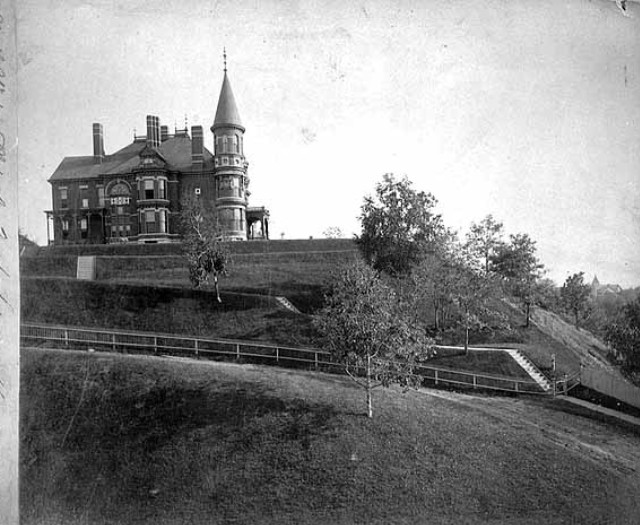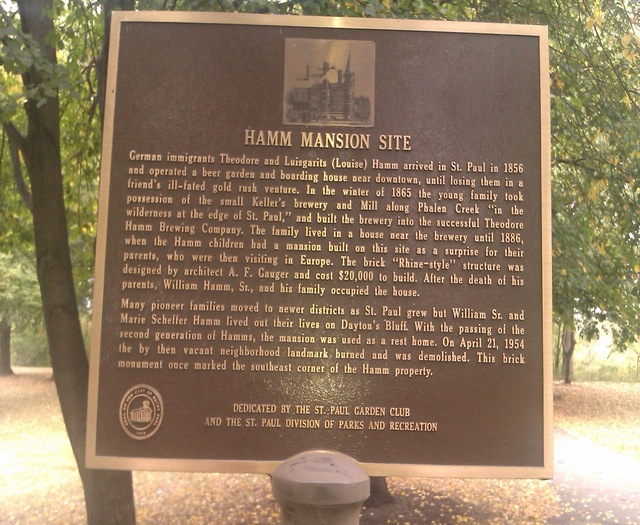The three-story home, built in 1886-1887 at the cost of $20,000, was a gift from the Hamm children to their parents, Theodore and Louise. It was presented to them in a small ceremony attended by the local paper in late May 1887, after the couple returned from a thirteen-month European vacation. Theodore, the ever-stoic patriarch of the family, was said to be appreciative of the gift, while his wife was reportedly overwhelmed. She had preferred their previous accommodations near the brewery employees' dorm-style housing.
There was something breathtaking about the red-brick manor overlooking Hamm's Brewery and Swede Hollow. It was designed by prominent St. Paul architect Augustus Gauger, boasting twenty rooms, eight fireplaces, and five chimneys. The asymmetric design, a hallmark of the Queen Anne style, featured a prominent wraparound porch and an elaborate corner turret that commanded views of the entire valley. Steam was piped up the hill from the brewery below to heat the mansion. The building rivaled the extraordinary homes on Summit Avenue.
Parties at the stately mansion on the bluff became yearly affairs attended by the city's elite and brewery workers. These elegant celebrations included a German band brought in from the city, Chinese lanterns spread throughout the yard, and tame deer and peacocks mingling among the guests as some of the entertaining highlights. Children from Swede Hollow climbed the hill to the outskirts of the Hamm grounds to watch the parties as they took place.
Theodore Hamm died of heart failure on July 31, 1903. His son, William Sr., and William's wife, Marie, then took over the house. Marie continued to live in the home after her husband William died in 1931.
On June 15, 1933, Theodore Hamm's grandson, William Hamm Jr., who was president of Hamm's Brewing Co., was abducted near his St. Paul office. He was on his way to the family mansion for lunch with his mother. Around 12:45 PM, four men from the Barker-Karpis Gang seized him near Greenbrier Street and Minnehaha Avenue East, a short distance from his workplace.
Marie Hamm passed away in September 1933. She was the last member of the Hamm family to live in the house, which then sat vacant and fell into disrepair. Eventually, it became the Robbin's Rest Hospital nursing home.
Just before noon on April 21, 1954, a fire broke out on the first and second floors of the now-vacant mansion. A fourteen-year-old student started the blaze by igniting bundles of newspapers he found inside the building. After setting the fire, he walked to a nearby laundromat and called the police, knowing he would be caught and wanting to face the consequences immediately.
The former mansion had sat unoccupied for only three weeks before the fires were set on April 21, 1954. The blaze caused $25,000 in damage. A short time later, after sixty-seven years of grandeur, the fire-weakened structure was deemed unsafe and demolished later that year.
For years, residents advocated for the former mansion site to be preserved as public green space. Local efforts, supported by the Saint Paul Garden Club and led in part by philanthropist Olivia Irvine Dodge, culminated in the establishment of Upper Swede Hollow Park. The site was formally dedicated in October 1976.
Upper Swede Hollow Park, a quaint park in its own right, serves today as a northeastern entrance down the steps into Swede Hollow below. While the Theodore Hamm mansion, a symbol of the city's brewing legacy, is no more, the park represents the ongoing transformation of St. Paul's East Side neighborhoods. The site illustrates how residential development patterns shift after the decline of industry, with public green space replacing former private estates. Upper Swede Hollow Park functions as both a recreational amenity and a historical marker, chronicling the area's shift from industrial prosperity to urban parkland.
 Minnesota Then
Minnesota Then

